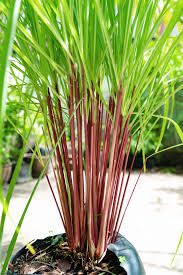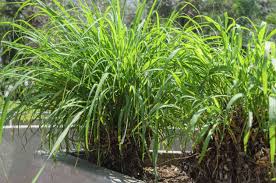Citronella Grass, scientifically known as Cymbopogon nardus, is a type of plant that is famous for its pleasant lemony fragrance. This grass is commonly found in tropical regions and is used for various purposes due to its distinct properties.
One of the most well-known features of Citronella Grass is its ability to repel insects. The strong scent that it emits acts as a natural insect repellent, helping to keep mosquitoes and other pesky bugs away. Because of this, Citronella Grass is often used in candles, oils, and sprays to create a bug-free environment during outdoor activities.
Aside from its insect-repelling qualities, Citronella Grass is also utilized in traditional medicine and aromatherapy. The essential oil extracted from the grass contains compounds that are believed to have antifungal and antibacterial properties. It’s used in massages and aromatherapy sessions to promote relaxation and alleviate stress.
Cultivating Citronella Grass is relatively easy, making it a popular choice for home gardeners. It thrives in well-drained soil and requires regular watering and sunlight. Gardeners often grow it in pots or directly in the ground, allowing the grass to reach a height of about 5 to 6 feet.
In addition, Citronella Grass is a versatile and useful plant with its natural insect-repelling properties and potential health benefits. Its delightful aroma and low maintenance requirements make it a favorite for both practical and ornamental purposes. Whether you’re seeking relief from insects or aiming to create a calming ambiance, Citronella Grass is a valuable addition to gardens and outdoor spaces.
Read Also: A Guide to Growing and Caring for Blue Oat Grass (Helictotrichon Sempervirens)
Growing and Care Guide of Citronella Grass

Growing and caring for Citronella Grass (Cymbopogon nardus) can be a rewarding experience. Here’s a simple guide to help you cultivate and maintain this fragrant plant:
1. Location: Choose a sunny spot in your garden or outdoor area for planting Citronella Grass. It requires at least 6 hours of direct sunlight each day to thrive.
2. Soil: Citronella Grass prefers well-draining soil with a slightly acidic to neutral pH (around 6.0 to 7.5). You can improve drainage by adding compost or sand to the soil.
3. Planting: You can start Citronella Grass from seeds, but it’s often easier to buy established plants from a nursery. Plant the grass in spring, after the last frost has passed. Space the plants about 2 to 3 feet apart to allow room for their growth.
4. Watering: Water the grass regularly, especially during the growing season. Keep the soil consistently moist but not waterlogged. Once the plants are established, they are relatively drought-tolerant and can withstand short periods of dryness.
5. Fertilization: Citronella Grass doesn’t require heavy fertilization. You can apply a balanced, slow-release fertilizer in the spring to encourage healthy growth. Follow the instructions on the fertilizer packaging.
6. Pruning: To maintain the plant’s height and encourage new growth, you can prune Citronella Grass by cutting back any dead or yellowing leaves. Pruning also helps promote the release of its aromatic oils.
7. Insect Repelling: The main reason for growing Citronella Grass is its insect-repelling properties. Crush a few leaves to release its fragrance and place them around your outdoor seating areas. You can also use the leaves to make DIY insect repellent sprays or candles.
8. Overwintering: In colder climates, Citronella Grass is often grown as an annual. However, if you’re in a warmer region, you can protect the plant during winter by cutting it back to a few inches above the ground and covering it with mulch. This will help it survive until the next growing season.
9. Container Growing: If you’re short on garden space or live in a colder area, you can grow Citronella Grass in containers. Choose a large pot with drainage holes and use well-draining potting mix. Place the container in a sunny location and bring it indoors during colder months.
10. Propagation: You can propagate Citronella Grass by dividing established clumps in spring. Dig up the clump, separate it into smaller sections, and replant them in well-prepared soil.
By following these simple steps, you can enjoy the benefits of Citronella Grass in your outdoor space. Its lovely fragrance and insect-repelling qualities make it a valuable addition to gardens, patios, and balconies.
Read Also: A Guide to Growing and Caring for Bent Grass
Importance of Citronella Grass

The importance of Citronella Grass (Cymbopogon nardus) lies in its various practical and beneficial qualities:
1. Natural Insect Repellent: One of the primary reasons for the popularity of Citronella Grass is its natural ability to repel insects, especially mosquitoes. The strong lemony aroma that the plant emits helps create a bug-free environment, reducing the risk of insect-borne diseases and providing comfort during outdoor activities.
2. Reduced Chemical Exposure: By using Citronella Grass as an insect repellent, individuals can reduce their reliance on chemical-based insecticides and sprays. This is not only beneficial for personal health but also contributes to environmental conservation by minimizing the release of harmful chemicals into the ecosystem.
3. Aromatherapy and Relaxation: The essential oil extracted from Citronella Grass contains compounds that are believed to have calming and stress-relieving properties. This makes it a popular choice for aromatherapy sessions and massages, contributing to mental and emotional well-being.
4. Traditional Medicine: Citronella Grass has been used in traditional medicine in some cultures. Its essential oil is thought to possess antifungal and antibacterial properties, making it a potential ingredient in natural remedies for certain ailments.
5. Gardening and Landscaping: Beyond its practical uses, Citronella Grass adds a decorative element to gardens and outdoor spaces. Its tall, grassy foliage and pleasant fragrance can enhance the aesthetic appeal of landscapes.
6. Educational Value: Growing Citronella Grass can be an educational experience for individuals, especially children. It provides an opportunity to learn about plant growth, care, and the ecological benefits of using natural insect repellents.
7. Contribution to Biodiversity: Citronella Grass can attract pollinators like bees and butterflies, supporting local biodiversity and ecosystem health.
8. Sustainable Gardening: Due to its hardiness and ability to thrive in various climates, Citronella Grass can be an environmentally friendly addition to gardens. Its low water requirements and natural insect-repelling qualities align with sustainable gardening practices.
In summary, Citronella Grass holds importance for its role in insect control, its potential health benefits, and its value in enhancing outdoor experiences. Whether used practically to ward off mosquitoes or incorporated into holistic practices like aromatherapy, this versatile plant offers multiple advantages to individuals and the environment alike.
Read Also: The Recycling Industry: A Comprehensive Guide
